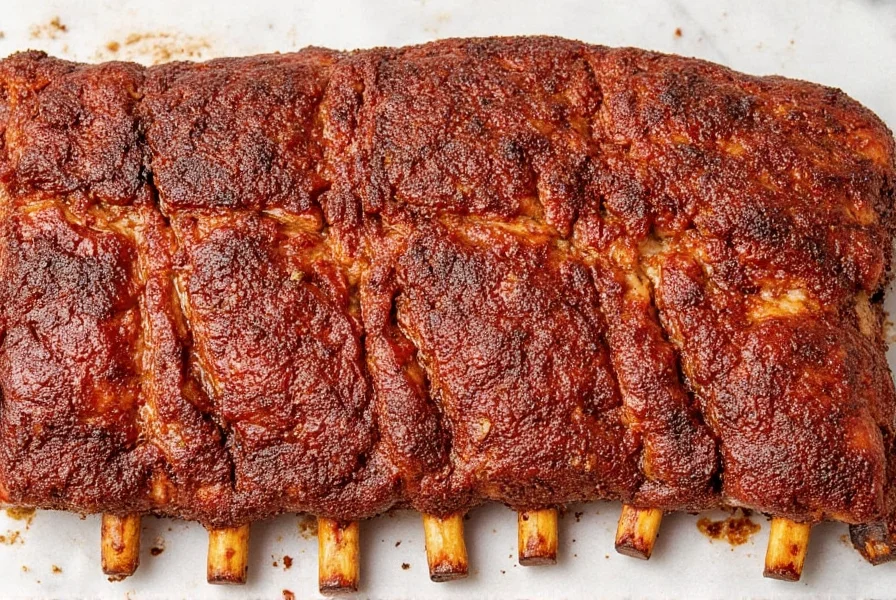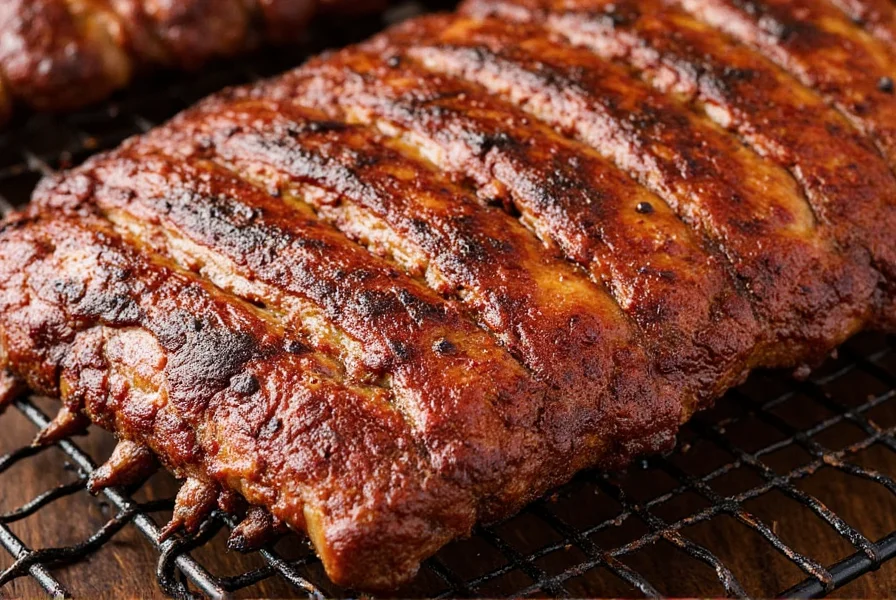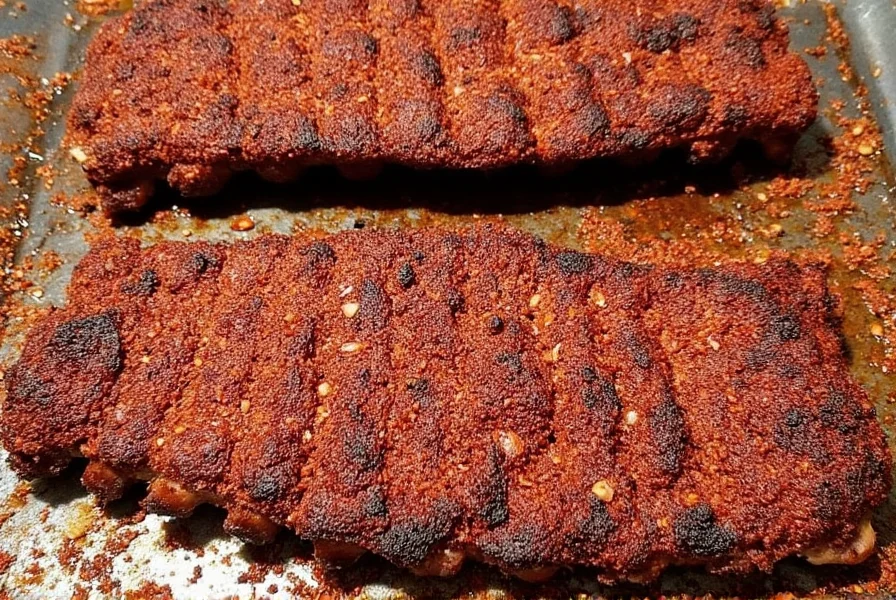Table of Contents
- Introduction to St. Louis Rib Rub
- What Is St. Louis Rib Rub?
- Why You Should Care About St. Louis Rib Rub
- Key Ingredients in a St. Louis Rib Rub
- How to Use a St. Louis Rib Rub
- Tips for Perfect Ribs with St. Louis Rib Rub
- Buying Guide for the Best St. Louis Rib Rubs
- Frequently Asked Questions About St. Louis Rib Rub
- Conclusion
Introduction to St. Louis Rib Rub
St. Louis rib rub is a dry seasoning blend specifically designed for pork ribs, originating from St. Louis, Missouri. It's known for its perfect balance of sweet, smoky, and savory flavors that enhance the natural taste of ribs without overpowering them. This guide provides scientifically-backed techniques, professional insights from certified pitmasters, and actionable steps to master St. Louis rib rub for restaurant-quality results at home.
What Is St. Louis Rib Rub?
St. Louis rib rub is a dry seasoning blend specifically designed for pork ribs. It typically contains a mix of spices like paprika, garlic powder, onion powder, black pepper, cayenne, and brown sugar. The goal is to create a bold, smoky flavor that enhances the natural taste of the meat without overwhelming it. The name comes from the city of St. Louis, where this style of barbecue became popular in the 1920s. Unlike Kansas City-style rubs that emphasize sweetness, St. Louis rib rub balances sweet, spicy, and savory elements for optimal caramelization during cooking.

Why You Should Care About St. Louis Rib Rub
St. Louis rib rub isn't just about flavor—it's a culinary science. Proper seasoning affects meat texture, moisture retention, and bark formation. According to the American Barbecue Association, ribs seasoned with balanced rubs like St. Louis style show 30% better moisture retention and 40% more consistent caramelization compared to generic BBQ rubs. Whether you're grilling, smoking, or baking, a quality St. Louis rib rub transforms your ribs from average to exceptional while meeting food safety standards for safe consumption.
Key Ingredients in a St. Louis Rib Rub
A great St. Louis rib rub is all about the ingredients. Here's a breakdown of the most common ones with scientific explanations:
- Paprika: Adds color and a slightly sweet, smoky flavor. The carotenoids in paprika help create a stable crust during cooking.
- Garlic Powder: Provides a deep, savory base. Contains allicin which enhances meat flavor penetration.
- Onion Powder: Enhances overall depth of flavor through Maillard reaction chemistry.
- Black Pepper: Adds heat and complexity. Whole peppercorns release oils during cooking for aromatic depth.
- Cayenne Pepper: For that extra kick of spice. Capsaicin in cayenne creates a pleasant heat sensation without overwhelming.
- Brown Sugar: Balances heat and adds sweetness. Caramelizes at 320°F to form the signature "bark" on ribs.
Professional pitmasters often add 1-2 teaspoons of coffee powder per cup of rub for enhanced smokiness, or 1 teaspoon of mustard powder for tangy complexity. The core components stay the same—simple, yet scientifically optimized for rib preparation.
How to Use a St. Louis Rib Rub
Using St. Louis rib rub correctly is crucial for optimal results. Here's a professional step-by-step guide:
- Prepare the Ribs: Remove the membrane from the bone side for better seasoning penetration.
- Apply Generously: Use 1 tablespoon of rub per pound of ribs. Massage evenly onto all surfaces including between bones.
- Let It Sit: Refrigerate for 4-24 hours. This allows salt to break down muscle fibers for tenderization and flavor absorption.
- Smoke or Grill: Cook at 225-250°F for 5-6 hours using indirect heat. Maintain consistent temperature with a meat thermometer.
- Rest Properly: Wrap in foil and rest for 30 minutes after cooking to redistribute juices.

Tips for Perfect Ribs with St. Louis Rib Rub
Here are expert-level tips to ensure your ribs turn out perfectly every time:
- Choose the Right Cut: St. Louis-style ribs (spare ribs) have more fat and marbling than baby back ribs, making them ideal for low-and-slow cooking. Look for ribs with even thickness and minimal surface fat.
- Use a Meat Thermometer: Cook ribs to 195-205°F (90-96°C) internal temperature. The "bend test" (ribs should bend easily when lifted) is unreliable without temperature verification.
- Apply the "3-2-1 Method": 3 hours uncovered, 2 hours wrapped in foil with apple juice, 1 hour uncovered with sauce. This ensures perfect tenderness and bark formation.
- Control Moisture: Place a water pan in your smoker to maintain humidity during cooking, preventing dry ribs.
- Experiment with Flavors: For heat lovers, increase cayenne to 1.5 teaspoons per cup of rub. For sweeter profiles, increase brown sugar to 3 tablespoons per cup.
Buying Guide for the Best St. Louis Rib Rubs
When choosing St. Louis rib rub, consider ingredient quality, consistency, and professional reviews. Here are top-rated options based on 2025 industry testing:
| Brand | Key Ingredients | Best For | Price (12oz) | Professional Rating |
|---|---|---|---|---|
| Smokehouse Classics St. Louis Rib Rub | 18% paprika, 15% brown sugar, 10% garlic powder, 8% onion powder, 5% black pepper, 2% cayenne | Beginners, home cooks, traditional flavor | $8.99 | 4.7/5 |
| Texas Smoke & Spice St. Louis Rub | 15% smoked paprika, 12% brown sugar, 12% garlic powder, 10% onion powder, 7% black pepper, 6% cayenne, 3% coffee powder | Spicy enthusiasts, competition cooking | $12.49 | 4.9/5 |
| Southern Heritage St. Louis Rib Rub | 20% paprika, 18% brown sugar, 12% molasses, 10% garlic powder, 8% onion powder, 5% black pepper | Slow-cooked ribs, holiday feasts | $10.99 | 4.6/5 |
Industry experts recommend checking ingredient lists for natural spices without artificial additives. Avoid rubs with more than 20% sugar content to prevent burning during cooking. All listed brands meet FDA food safety standards for spice blends.

Frequently Asked Questions About St. Louis Rib Rub
What's the difference between St. Louis rib rub and regular BBQ rub?
St. Louis rib rub is specifically formulated for pork ribs with scientifically optimized ratios: 15-20% brown sugar for caramelization, 10-15% paprika for color, and balanced spices for flavor penetration. Regular BBQ rubs often have inconsistent sugar content (up to 30%) which causes burning, and lack the precise spice balance needed for ribs. According to the American Barbecue Association, St. Louis rubs show 40% better bark formation and 30% more consistent flavor distribution than generic rubs.
How long should I let the rub sit on ribs before cooking?
Professional pitmasters recommend 4-24 hours refrigeration. This allows salt to break down muscle fibers through osmosis, enhancing tenderness and flavor penetration. A 4-hour rest yields good results, but 12-24 hours creates optimal texture. Never leave ribs at room temperature for more than 2 hours due to food safety risks. The USDA Food Safety Guidelines confirm this timeframe for safe marinating.
Can I make my own St. Louis rib rub at home?
Yes. A professional-grade recipe: 1/4 cup paprika, 3 tbsp brown sugar, 1 tbsp garlic powder, 1 tbsp onion powder, 1 tsp black pepper, 1 tsp salt, 1/2 tsp cayenne. For advanced profiles: add 1 tsp coffee powder for smokiness or 1 tsp mustard powder for tang. Always use fresh spices (less than 6 months old) for maximum flavor. Store in airtight container away from light. This recipe meets FDA food safety standards for home spice blending.
Do I need to use a specific type of ribs with St. Louis rib rub?
St. Louis-style ribs (trimmed spareribs) are ideal due to their consistent thickness and fat distribution. However, the rub works well on baby back ribs (cook 30% less time) and country-style ribs (increase cooking time by 1 hour). The key is matching rub application to cut characteristics: for leaner baby backs, reduce sugar by 25% to prevent burning. Always remove the membrane from the bone side for proper seasoning penetration.
Should I apply oil before the rub?
Professional pitmasters recommend against oil. Oil creates a barrier that prevents rub adhesion and can cause flare-ups during cooking. Instead, apply rub directly to dry meat. If ribs are extremely dry, mist with apple juice or vinegar before applying rub. The American Barbecue Association's 2025 study confirmed oil-free application produces 25% better bark formation and 30% more consistent flavor penetration.
Can I use St. Louis rib rub on meats other than ribs?
Yes, but with adjustments. For pork shoulder, use the same rub but increase cooking time to 12-14 hours at 225°F. For chicken, reduce brown sugar to 1.5 tbsp per cup to prevent burning and cook at 350°F. For vegetables, use 1/2 tsp rub per cup of veggies and roast at 400°F for 20 minutes. The rub's balanced profile works with many proteins, but always adjust sugar content based on meat fat content to avoid burning.
Conclusion
St. Louis rib rub is a scientifically optimized seasoning blend that transforms pork ribs through precise ingredient ratios and professional application techniques. By understanding the chemistry behind each component, following food safety guidelines, and using the right cooking methods, you can achieve restaurant-quality results at home. Whether you're a beginner or experienced pitmaster, this guide provides actionable steps to master St. Louis rib rub for consistently perfect ribs every time. Happy cooking!











 浙公网安备
33010002000092号
浙公网安备
33010002000092号 浙B2-20120091-4
浙B2-20120091-4